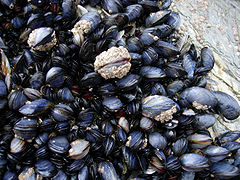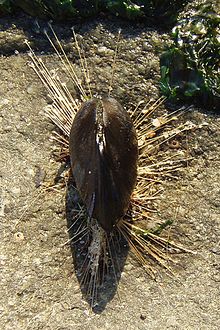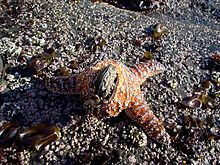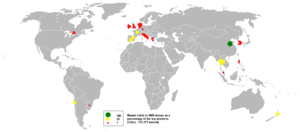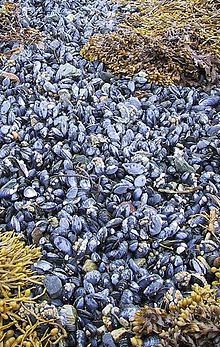- Mussel
-
Mussel Blue mussels Mytilus edulis in the intertidal zone in Cornwall, England Scientific classification Kingdom: Animalia Phylum: Mollusca Class: Bivalvia Subclasses Pteriomorphia (marine mussels)
Palaeoheterodonta (freshwater mussels)
Heterodonta (zebra mussels)The common name mussel is used for members of several families of clams or bivalvia mollusca, from saltwater and freshwater habitats. These groups have in common a shell whose outline is elongated and asymmetrical compared with other edible clams, which are often more or less rounded or oval.
The word "mussel" is most frequently used to mean the edible bivalves of the marine family Mytilidae, most of which live on exposed shores in the intertidal zone, attached by means of their strong byssal threads ("beard") to a firm substrate. A few species (in the genus Bathymodiolus) have colonised hydrothermal vents associated with deep ocean ridges.
In most marine mussels the shell is longer than it is wide, being wedge-shaped or asymmetrical. The external colour of the shell is often dark blue, blackish, or brown, while the interior is silvery and somewhat nacreous.
The word "mussel" is also used for many freshwater bivalves, including the freshwater pearl mussels. Freshwater mussel species inhabit lakes, ponds, rivers, creeks, canals, grouped in a different subclass, despite some very superficial similarities in appearance.
Freshwater Zebra mussels and their relatives in the family Dreissenidae are not related to previously mentioned groups, even though they resemble many Mytilus species in shape, and live attached to rocks and other hard surfaces in a similar manner, using a byssus. They are classified with the Heterodonta, the taxonomic group which includes most of the bivalves commonly referred to as "clams".
Contents
General anatomy
 Marine blue mussel, Mytilus edulis, showing some of the inner anatomy. The white posterior adductor muscle is visible in the upper image, and has been cut in the lower image to allow the valves to open fully.
Marine blue mussel, Mytilus edulis, showing some of the inner anatomy. The white posterior adductor muscle is visible in the upper image, and has been cut in the lower image to allow the valves to open fully.
The mussel's external shell is composed of two hinged halves or "valves". The valves are joined together on the outside by a ligament, and are closed when necessary by strong internal muscles. Mussel shells carry out a variety of functions, including support for soft tissues, protection from predators and protection against desiccation.
The shell has three layers. In the pearly mussels there is an inner iridescent layer of nacre (mother-of-pearl) composed of calcium carbonate, which is continuously secreted by the mantle; the prismatic layer, a middle layer of chalky white crystals of calcium carbonate in a protein matrix; and the periostracum, an outer pigmented layer resembling a skin. The periostracum is composed of a protein called conchin, and its function is to protect the prismatic layer from abrasion and dissolution by acids (especially important in freshwater forms where the decay of leaf materials produces acids).
Like most bivalves, mussels have a large organ called a foot. In freshwater mussels, the foot is large, muscular, and generally hatchet-shaped. It is used to pull the animal through the substrate (typically sand, gravel, or silt) in which it lies partially buried. It does this by repeatedly advancing the foot through the substrate, expanding the end so it serves as an anchor, and then pulling the rest of the animal with its shell forward. It also serves as a fleshy anchor when the animal is stationary.
In marine mussels, the foot is smaller, tongue-like in shape, with a groove on the ventral surface which is continuous with the byssus pit. In this pit, a viscous secretion is exuded, entering the groove and hardening gradually upon contact with sea water. This forms extremely tough, strong, elastic, byssus threads that secure the mussel to its substrate. The byssus thread is also sometimes used by mussels as a defensive measure, to tether predatory molluscs, such as dog whelks, that invade mussel beds, immobilising them and thus starving them to death.
In cooking, the byssus of the mussel is known as the "beard" and is removed before the mussels are prepared.
Life habits
Feeding
Both marine and freshwater mussels are filter feeders; they feed on plankton and other microscopic sea creatures which are free-floating in seawater. A mussel draws water in through its incurrent siphon. The water is then brought into the branchial chamber by the actions of the cilia located on the gills for ciliary-mucus feeding. The wastewater exits through the excurrent siphon. The labial palps finally funnel the food into the mouth, where digestion begins.
Marine mussels are usually found clumping together on wave-washed rocks, each attached to the rock by its byssus. The clumping habit helps hold the mussels firm against the force of the waves. At low tide mussels in the middle of a clump will undergo less water loss because of water capture by the other mussels.
Reproduction
Both marine and freshwater mussels are gonochoristic, with separate male and female individuals. In marine mussels, fertilization occurs outside the body, with a larval stage that drifts for three weeks to six months, before settling on a hard surface as a young mussel. There, it is capable of moving slowly by means of attaching and detaching byssal threads to attain a better life position.
Freshwater mussels reproduce sexually. Sperm is released by the male directly into the water and enters the female via the incurrent siphon. After fertilization, the eggs develop into a larval stage called a glochidium (plural glochidia), which temporarily parasitize fish, attaching themselves to the fish's fins or gills. Prior to their release, the glochidia grow in the gills of the female mussel where they are constantly flushed with oxygen-rich water. In some species, release occurs when a fish attempts to attack the mussel's minnow or other mantle flaps shaped like prey; an example of aggressive mimicry.
Glochidia are generally species-specific, and will only live if they find the correct fish host. Once the larval mussels attach to the fish, the fish body reacts to cover them with cells forming a cyst, where the glochidia remain for two to five weeks (depending on temperature). They grow, break free from the host, and drop to the bottom of the water to begin an independent life.
Predators
Marine mussels are eaten by humans, starfish, seabirds, and by numerous species of predatory marine gastropods in the family Muricidae, such as the dog whelk, Nucella lapillus.
Freshwater mussels are eaten by otters, raccoons, ducks, baboons (off the coast of South Africa) and geese.
Distribution and habitat
Marine mussels are abundant in the low and mid intertidal zone in temperate seas globally.
Other species of marine mussel live in tropical intertidal areas, but not in the same huge numbers as in temperate zones.
Certain species of marine mussels prefer salt marshes or quiet bays, while others thrive in pounding surf, completely covering wave-washed rocks. Some species have colonized abyssal depths near hydrothermal vents. The South African white mussel exceptionally doesn't bind itself to rocks but burrows into sandy beaches extending two tubes above the sand surface for ingestion of food and water and exhausting wastes.
Freshwater mussels inhabit permanent lakes, rivers, canals and streams throughout the world except in the polar regions. They require a constant source of cool, clean water. They prefer water with a substantial mineral content, using calcium carbonate to build their shells.
Aquaculture
In 2005, China accounted for 40 per cent of the global mussel catch according to a FAO study.[1] Within Europe, Spain remained the industry leader. In North America, 80% of cultured mussels are produced in Prince Edward Island in Canada.[2]
Freshwater mussels are used as host animals for the cultivation of freshwater pearls. Some species of marine mussel, including the Blue Mussel (Mytilus edulis) and the New Zealand green-lipped mussel (Perna canaliculus), are also cultivated as a source of food.
There are a variety of techniques for growing mussels.
- Intertidal growth technique, or bouchot technique: pilings, known in French as bouchots, are planted at sea; ropes, on which the mussels grow, are tied in a spiral on the pilings; some mesh netting prevents the mussels from falling away. This method needs an extended tidal zone.
- Mussels are cultivated extensively in New Zealand, where the most common method is to attach mussels to ropes which are hung from a rope back-bone supported by large plastic floats. The most common species cultivated in New Zealand is the New Zealand green-lipped mussel.
Mussels as food
Humans have used mussels as food for thousands of years and continue to do so. About 17 species are edible, of which the most commonly eaten are Mytilus edulis, M. galloprovincialis, M. trossellus and Perna canaliculus.[3]
Freshwater mussels nowadays are generally considered to be unpalatable, though the native peoples in North America ate them extensively. During the second World War in the United States, mussels were commonly served in diners. This was due to the unavailability of red meat related to wartime rationing.[4]
In Belgium, the Netherlands, and France, mussels are consumed with french fries ("mosselen met friet" or "moules frites") or bread. In Belgium, mussels are often served with fresh herbs and flavorful vegetables in a stock of butter and white wine. Frites/Frieten and Belgian beer are popular accompaniments. In the Netherlands, mussels are sometimes served fried in batter or breadcrumbs, particularly at take-out food outlets or informal settings. In France, the Éclade des Moules is a mussel bake popular along the beaches of the Bay of Biscay.
In Italy, mussels are often mixed with other sea food, or eaten with pasta.
In Spain, they are consumed mostly steam cooked, sometimes boiling white wine, onion and herbs, and served with the remaining water and some lemon. It's also common eat them as "tigres", a sort of croquette using the mussel meat, shrimps and other pieces of fish in a thick bechamel, breaded and fried in the clean mussel shell. They are used in other sort of dishes, as rices or soups, or commonly eaten canned in a pickling brine made of oil, vinegar, peppercorns, bay leaves and paprika.
In Turkey, mussels are either covered with flour and fried on shishs ('midye tava'), or filled with rice and served cold ('midye dolma') and are usually consumed with alcohol (mostly with raki or beer).
They are used in Ireland boiled and seasoned with vinegar, with the "bray" or boiling water as a supplementary hot drink.
In Cantonese cuisine, mussels are cooked in a broth of garlic and fermented black bean. In New Zealand, they are served in a chili or garlic-based vinaigrette, processed into fritters and fried, or used as the base for a chowder. In India, mussels are popular in Kerala, Maharashtra, Bhatkal, and Goa. They are either prepared with drumsticks, breadfruit or other vegetables, or filled with rice and coconut paste with spices and served hot. Fried mussels ('Kadukka' in Malayalam) of north Kerala are a spicy, favored delicacy.
Preparation
Mussels can be smoked, boiled, steamed, roasted, barbecued or fried in butter.
As with all shellfish, except shrimp, mussels should be checked to ensure they are still alive just before they are cooked; enzymes quickly break down the meat and make them unpalatable after dying.[citation needed] A simple criterion is that live mussels, when in the air, will shut tightly when disturbed. Open, unresponsive mussels are dead, and must be discarded. Unusually heavy, wild caught, closed mussels may be discarded as they may contain only mud or sand. (They can be tested by slightly opening the shell halves.)
A thorough rinse in water and removal of "the beard" is suggested. Mussel shells usually open when cooked, revealing the cooked soft parts.
Although mussels are valued as food, mussel poisoning due to toxic planktonic organisms can be a danger along some coastlines. For instance, mussels should be avoided along the west coast of the United States during the warmer months. This poisoning is usually due to a bloom of dinoflagellates (red tides), which contain toxins. The dinoflagellates and their toxin are harmless to mussels, even when concentrated by the mussel's filter feeding, but if the mussels are consumed by humans, the concentrated toxins cause serious illness, such as paralytic shellfish poisoning. Usually the U.S. government monitors the levels of toxins throughout the year at fishing sites. See Red Tide.
Nutrition highlights
Raw blue mussels[5] Serving size 3 ounces (85 g) Calories 70 Protein 10.1 g Carbohydrate 3.1 g Fiber 0.0 g Total fat 1.9 g Saturated fat 0.4 g Sodium 243 mg - Excellent source of: Selenium (76 mcg), and vitamin B12 (20 mcg)
- Good source of: Zinc (2.3 mg), and folate (64 mcg)
Foods that are an “excellent source” of a particular nutrient provide 20% or more of the recommended daily value. Foods that are a “good source” of a particular nutrient provide between 10 and 20% of the recommended daily value.
See also
References
- ^ China catches 0.77m tonnes of mussels in 2005
- ^ Calta, Marialisa (August 28, 2005). "Mussels on Prince Edward Island". New York Times. http://travel.nytimes.com/2005/08/28/travel/28foraging.html. Retrieved April 26, 2009.
- ^ Zeldes, Leah A. (2010-10-13). "Eat this! Mussels, mighty fine mollusks". Dining Chicago. Chicago's Restaurant & Entertainment Guide, Inc.. http://www.diningchicago.com/blog/2010/10/13/eat-this-mussels-mighty-fine-mollusks/. Retrieved 2010=11-17.
- ^ Alton Brown, Good Eats,
- ^ http://www.calorieking.com/foods/calories-in-shellfish-fresh-mussel-blue-raw_f-Y2lkPTM5MjQzJmJpZD0xJmZpZD02MjM1NiZlaWQ9MzU3ODkwMTc2JnBvcz0yJnBhcj0ma2V5PW11c3NlbA.html
External links
- Discover Mussels - Mussel Industry Council Mussel information and recipes
- Freshwater Mussel Genera
- Methods of mussel farming
- Photo of bouchot pilings for growing mussels
- Mississippi River Mussels
- Marine Ecology Station
- Newcastle University Biofouling Group Studying the physiology and behaviour of marine fouling organisms
- Nutrition Facts for Mussels
Commercial mollusks Marine gastropods - Abalone
- Periwinkle
- Whelk
- Buccinum undatum
- Bullacta exarata
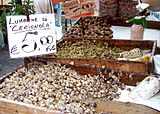
Land and freshwater gastropods - Helix pomatia
- Helix aspersa
- Helix aperta
- Cepaea nemoralis
- Otala lactea
- Escargot
Free-swimming marine bivalves - Scallop
- Queen scallop
- Pecten maximus
- Pecten jacobaeus
- Argopecten irradians
- Placopecten magellanicus
Infaunal bivalves - Clam
- (Atlantic surf clam
- Soft-shell clam)
- Mercenaria mercenaria
- Austrovenus stutchburyi
- Saxidomus nutalli
- Arctica islandica
- Cockle
- Geoduck
- Spisula solidissima
- Paphies ventricosa
- Paphies australis
- Tuatua
- Ruditapes largillierti
- Grooved carpet shell
Sessile bivalves - Oyster
- Mussel
- Pearl oyster
Freshwater bivalves Cephalopods Techniques List of fishing topics by subject Principal commercial fishery species groups Wild Forage fishOther wild fishMolluscs- Sea cucumbers
- Sea urchin
- more...



Farmed Edible mollusks Bivalves Atlantic jackknife • Atlantic surf • Geoduck • Grooved carpet shell • Hard clam • Horse • Mactra stultorum • Blunt gaper • Ocean quahog • Pacific razor • Pecten jacobaeus • Venus • California butterclam • Senilia senilis • Smooth clam • Soft-shell • Triangle shell • Tuatua • Japanese littleneck • Razor clam • Pod razor • Ensis (razor genus) • PaphiesMusselsBlue • Mediterranean • New Zealand green-lipped • California • Brown • Asian/Philippine green • Date • Mytilidae (mussel family)Auckland • Eastern • Olympia • Southern mud • Colchester native • Pacific • Portuguese • Windowpane • Rock • Sydney rock • Ostra chilena/Bluff • Gillardeau oysters • Crassostrea ("true oyster" genus)Gastropods Queen • DogBlack foot opihi/Haiwaiian • China • Common European • Rayed Mediterranean • Ribbed Mediterranean • Rustic • Turtle/Talc • Yellow foot opihiLandFreshwaterNeritesInkfish Spineless • BottletailChitons Chiton magnificus • Acanthopleura granulataRelated topics: Oyster farming • Land snail farming • Categories:- Belgian cuisine
- Bivalves
- Commercial molluscs
- Edible molluscs
- Seafood
Wikimedia Foundation. 2010.

